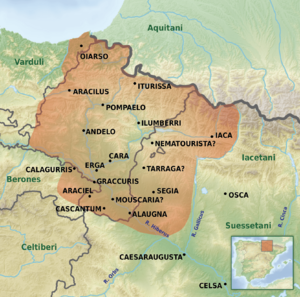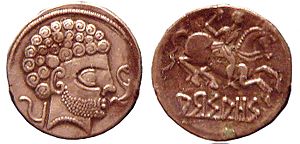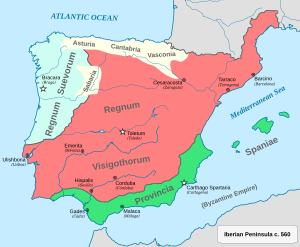Vascones facts for kids
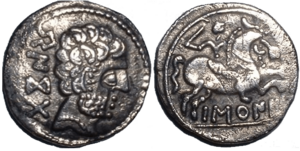
The Vascones were an ancient tribe. They lived in the Iberian Peninsula before the Romans arrived. Their land was between the Ebro river and the western Pyrenees mountains. This area is now Navarre, western Aragon, and northeastern La Rioja. Many people believe the Vascones were the ancestors of today's Basques. The Basques even got their name from the Vascones.
Contents
Where the Vascones Lived
During Roman Times
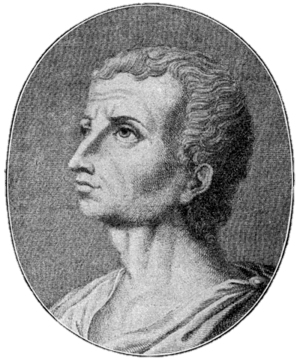
Ancient writers like Livy, Strabo, Pliny the Elder, and Ptolemy described where the Vascones lived. These writings are from the 1st century BC to the 2nd century AD.
The oldest record is from Livy (59 BC – AD 17). He wrote about the Sertorian War in 76 BC. He said that after crossing the Ebro river and the city of Calagurris Nasica, people went through the flatlands of the Vascones. This area was called Vasconum agrum. They then reached the land of their neighbors, the Berones. This border was to the west. To the south, the Vascones' neighbors were the Celtiberians, near their city Contrebia Leucade.
Pliny the Elder wrote in his book Natural History that the Vascones lived at the western end of the Pyrenees. They were neighbors with the Varduli. Their land reached the mountains of Oiarso and the Bay of Biscay coast. He called this area Vasconum saltus.
The Greek geographer Strabo (around 63 BC – AD 14) also wrote about the Vascones. He said their main city was Pompaelo, and also Callagurris.
Both cities, Kalágouris, one of the main cities of the ouáskones,... This same region is crossed by the road that comes from Terrakon and goes to the ouáskones, in the border of the Ocean, to Pompélon and Oiáson, city built above the very same Ocean.
—Strabo
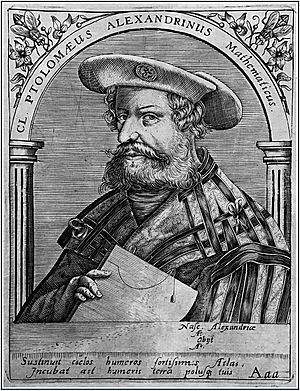
Ptolemy (1st and 2nd Century AD) also gave details. In his book Geōgraphikḕ Hyphḗgēsis, he listed 15 cities in Vascones territory. These included Pompaelo, Calagurris, and Iacca.
During the Roman Republic and Empire, the Vascones' land covered today's Navarre, parts of Gipuzkoa, La Rioja, Zaragoza, and Huesca. This included the city of Calagurris.
Later Centuries: 3rd and 4th
After Ptolemy's time, there are not many records about the Vascones. This was a time of change due to Germanic invasions.
Some historians believe the Vascones' territory grew during this time. They might have expanded west into lands of other tribes like the Caristii and Varduli. They also might have moved north into Aquitaine. This idea helps explain why the region of Gascony got its name from "Vascon."
Another idea suggests that the Goths and Franks started calling all Basque-speaking or non-Romanized tribes "Vascones." This means the name might have covered a larger group of people.
The 7th Century
By the 7th century, historians began to talk about two areas: Spagnovasconia (southwest of the Pyrenees, in Spain) and Guasconia (northwest of the Pyrenees, in Aquitaine). Some think the Vascones had moved north by this time.
In 810, a writer named Einhard used the term "Navarrese" for the first time. He used it to describe people living in the old Vascones lands near the Ebro river.
History of the Vascones
Roman Period
The Vascones seemed to have a good relationship with the Roman Empire. They were different from other tribes like the Aquitanians. During the Sertorian War, the Roman general Pompey set up his base in their land. He founded the city of Pompaelo.
Roman culture became strong in the Ebro valley, called Ager Vasconum. But in the mountainous Saltus, Roman influence was less. It was mostly seen in mining areas, ports, and roads. The Vascones' land was important for Romans. It was a key connection point between northern Hispania and southwestern Gallia.
In the 4th and 5th centuries, the Vascones' area saw some trouble. There were signs of burnt farms and many coins made to pay soldiers. Historians link this to local uprisings against feudalization. It was also a time when different Germanic tribes like the Vandals and Visigoths moved into Hispania.
Late Antiquity and Early Middle Ages
In AD 407, Vascon troops helped Roman commanders fight off attacks from the Vandals and other tribes. In 409, these tribes moved into Hispania without much resistance. The Romans then made a deal with the Visigoths. They gave them land in return for their help in fighting the invaders. The Visigoths soon pushed the Vandals out to Africa.
By the 7th and 8th centuries, the Vascones were living in a much larger area. This stretched from Álava in the west to the Loire river in the north. The term "Vascones" started to mean all Basque-speaking tribes.
The independent Vascones formed their first political group under the Franks. This was the Duchy of Vasconia. Its southern borders were not clear. This duchy later became Gascony.
In 778, the Vascones defeated Charlemagne's army at the Battle of Roncevaux Pass. This happened after Charlemagne tried to conquer Zaragoza. Frankish writers called this "wasconicam perfidiam" (Vascon betrayal).
Later, Pamplona was taken by the Cordovan emir in 781. But the Franks took it back in 806. In 824, there was a second battle of Roncevaux. This led to the creation of the Kingdom of Pamplona. Eneko Arista became its first leader. Arab sources called him the leader of the Vascones.
After the 9th century, the term "Vascones" became more linked to the area of Gascony. This region was still Basque-speaking then, but a new Romance language, Gascon, was slowly taking over.
Vascones Culture
Language and Writing
Many experts believe that before the Romans arrived, the Vascones spoke a language that was an early form of modern Basque language. This language is sometimes called Proto-Basque language or Aquitanian language.
However, the exact origin of the Basque language is still a mystery. There are different ideas about where it came from. Some think it developed right where it is now. Others suggest it might be related to languages from the languages of the Caucasus or the old Iberian language. So far, these connections have not been fully proven.
We don't have many direct records from ancient times about the Vascones' language. But studying old inscriptions has been very helpful. Writing was introduced to the Vascones around the 2nd century. The oldest written examples are from coins.
A very important discovery was a tombstone found in Lerga. It was thought to be the oldest written example of the Proto-Basque language. But in 2022, an even older inscription from the 1st century BC was found. It is also believed that the Iberian language influenced Basque. For example, the Iberian word ili became hiri in Basque, meaning "town" or "city." This word is part of the Vasconic name for Pompaelo: "Iruña."
Religion
Old inscriptions and archaeological finds tell us about the Vascones' religious practices. When the Romans arrived, their beliefs mixed with the Vascones' own religions. This mix of beliefs lasted until the 1st century. After that, Roman mythology became more common, until Christianity was adopted between the 4th and 5th centuries.
Names of Vasconic gods have been found on tombstones and altars. This shows how Roman and Vasconic religions blended. For example, two altars were found in Ujué. One was for Lacubegi, believed to be a "God of the lower world." The other was for Jupiter. Two tombstones found in Lerate and Barbarin were for Stelaitse. These are from the 1st century.
See also
 In Spanish: Vascones (Edad Antigua) para niños
In Spanish: Vascones (Edad Antigua) para niños
- Pre-Roman peoples of the Iberian Peninsula


